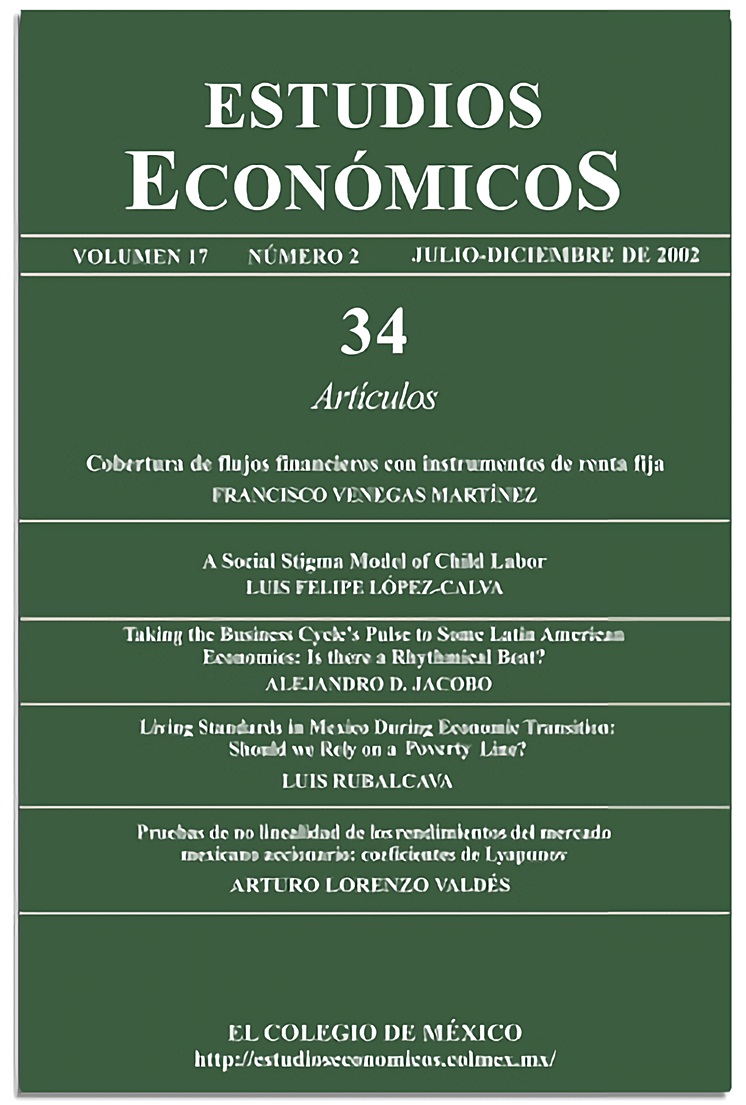Artículos
Llevando el pulso del ciclo económico a algunas economías latinoamericanas: ¿existe una pulsación rítmica?
Publicado 2002-07-01
Palabras clave
- Argentina,
- Chile,
- Bolivia,
- Paraguay,
- Uruguay
- fluctuaciones económicas,
- oferta y demanda ...Más
Cómo citar
D. Jacobo, A. (2002). Llevando el pulso del ciclo económico a algunas economías latinoamericanas: ¿existe una pulsación rítmica?. Estudios Económicos De El Colegio De México, 17(2), 219–245. https://doi.org/10.24201/ee.v17i2.193
Resumen
Este trabajo se ocupa del comportamiento macroeconómico de Argentina, Bolivia, Chile, Paraguay y Uruguay durante el período 1970- 1997, con un doble propósito. El primero, determinar si las fluctuaciones económicas han tenido una conducta similar de acuerdo con su duración, intensidad y momento de ocurrencia. El segundo, caracterizar las perturbaciones de demanda y oferta. El comportamiento de estas economías en el pasado revela que la posibilidad de armonizar políticas macroeconómicas es débil, y sugiere la ausencia de un argumento económico para una unión monetaria.
Descargas
Los datos de descargas todavía no están disponibles.
Citas
- Agenor, P., C. J. McDermott and E. Prasad (1998). Macroeconomic Fluctuations in Developing Countries. Some Stylized Facts, EDI Working Paper.
- Arnaudo, A. and A. Jacobo (1998). “Policy Harmozation in Mercosur”, Economía Aplicada, 2 (4), pp. 757-766.
- Arnaudo, A. and A. Jacobo (1997). “Macroeconomic Homogeneity within Mercosur: An Overview”, Estudios Económicos, 12 (1), pp. 37-51.
- Bayoumi, T. and B. Eichengreen (1992a). Is There a Conflict Between EC Enlargement and European Monetary Unification?, NBER Working Paper Series, No. 3950.
- Bayoumi, T. and B. Eichengreen (1992b). Shocking Aspects of European Monetary Unification, NBER, No. 3949.
- Beveridge, S. and C. Nelson (1981). “A New Approach to Decomposition of Economic Time Series in to Permanent and Transitory Components with Particular Attention to Measurement of ´Business Cycle´”, Journal of Monetary Economics, 7 (2), pp. 151-174.
- Blanchard, O. and D. Quah (1989). “The Dynamic Effects of Aggregate Demand and Supply Disturbances”, American Economic Review, 79 (4), pp. 655-673.
- Burns, A. and W. Mitchell (1946). Measuring Business Cycle, NBER.
- Carrera, J., M. Féliz and D. Panigo (1999). Una medición de los canales de transmisión de las fluctuaciones económicas. El caso de Argentina y los Estados Unidos, 34 Annual Meeting, Asociación Argentina de Economía Política, (draft).
- Christodoulakis, N., S. Dimelis and T. Kollintzas (1995). “Comparisons of Business Cycles in the EC: Idiosyncrasies and Regularities”, Economía, 62 (245), pp. 1-27.
- Eichengreen, B. (1993). “European Monetary Unification”, Journal of Economic Literature, 31 (3), pp. 1321-1357.
- Enders, W. (1995). Applied Econometric Times Series, John Wiley & Sons Inc., New York.
- Fackler, J. and W. McMillin (1998). “Historical Decomposition of Aggregate Demand and Supply Shocks in a Small Macro Model”, Southern Economic Journal, 64 (3), pp. 648-664.
- Fiorito, R. and T. Kollintzas (1994). “Stylized Facts of Business Cycle in the G7 from a Real Business Cycle Perspective”, European Economic Review, 38 (2), pp. 235-269.
- FMI (1997). “Zonas monetarias óptimas: un desafio de políticas”, Boletín, 26 (1), pp. 14-16.
- Fullerton, T. (Jr.) and E. Araki (1996). “New Directions in Latin American Macroeconometrics”, Economic and Business Review, 38 (12), pp. 49-73.
- Funke, M. (1997a). “How Important are Demand and Supply Shocks in Explaining German Business Cycle?: New Evidence on an Old Debate”, Economic Modelling, 14 (1), pp. 11-37.
- Funke, M. (1997b). “The Nature of Shocks in Europe and in Germany”, Economica, 64 (255), pp. 461-469.
- Galí, J. (1992). “How Well Does the IS-LM Model Fit Postwar US Data?”, Quarterly Journal of Economics, 107 (2), pp. 709-738.
- IMF. International Financial Statistics, various issues.
- Jacobo, A. (2001). Some Empirical Evidence on the Macroeconomic Behavior of Mercosur Countries, (draft).
- Karras, G. (1993). “Sources of US Macroeconomic Fluctuations: 1973-1989”, Journal of Macroeconomics, 15 (1), pp. 47-68.
- King, R., et al. (1991). “Stochastic Trends and Economic Fluctuations”, American Economic Review, 81 (4), pp. 819-840.
- Kydland, F. and E. Prescott (1990). “Business Cycles: Real Facts and Monetary Myth”, Federal Bank of Minneapolis Quarterly Review, Spring.
- Lucas, R. Jr. (1977). “Understanding Business Cycles”, in K. Brunner y A. Meltzer (Eds.), Stabilization of Domestic and International Economy, Carnegie-Rochester Conferences Series on Public Policy, vol. 5, North-Holland.
- Martirena-Mantel, A. (1997). “Reflexiones sobre uniones monetarias: pensando el Mercosur desde el caso europeo”, Academia Nacional de Ciencias Económicas.
- Mena, H. (1995). “Pushing the Sisyphean Boulder? Macroeconometric Testing in Latin American Countries”, Review of Income and Wealth, 10 (1), pp. 81-99.
- Mundell, R. (1961). “A Theory of Optimum Currency Areas”, American Economic Review, 51 (4), pp. 657-665.
- Nelson, C. and C. Plosser (1982). “Trends and Random Walks in Macroeconomic Time Series”, Journal of Monetary Economics, 10 (2): 139-162.
- ONU-CEPAL. Anuario Estadístico de América Latina y El Caribe, various issues.
- ONU-CEPAL. Estudios Económicos de América Latina, various issues.
- Shapiro, M. and M. Watson (1988). “Sources of Business Cycle Fluctuations”, NBER Macroeconomic Annual, pp. 112-148.
- Sterne, G. and T. Bayoumi (1995). “Temporary Cycles or Volatile Trends? Economic Fluctuations in 21 OECD Economies”, The Manchester School, 63 (1), pp. 23-51.
- Wyplosz, C. (1997). “EMU: Why and How it Might Happen”, Journal of Economic Perspectives, 11 (4), pp. 3-22.

